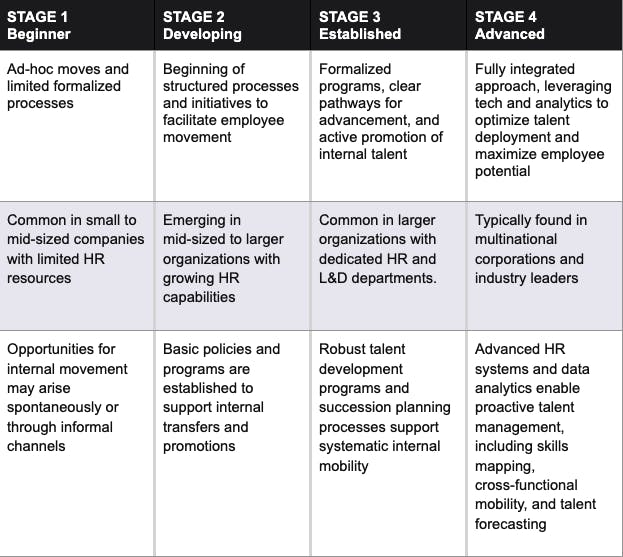
Internal Mobility: What It Is and Why You Need It
Explore what internal mobility is, who’s in charge of it, how companies can get better at it, and why it matters for business success.
Written by
Katelyn Rattray,
Internal mobility is all about giving employees the chance to move around within a company, taking on new roles or shifting to different departments. It's a win-win: employees get to grow their skills and experiences, and companies keep their talent engaged and happy. And the benefits to the bottom line are clear: better employee engagement, higher retention rates, and big savings on hiring and training costs. Let’s explore what internal mobility is, who’s in charge of it, how companies can get better at it, and why it matters for business success.
What is internal mobility?
Internal mobility is the process of strategically moving employees within an organization to fill new roles, address skill gaps, or make the most of their talents, all without needing to hire from outside the company. It's about finding the right people for the right positions from within your existing workforce.
Internal mobility can take several forms. Lateral moves involve employees shifting to different roles at the same level, allowing them to gain new experiences and skills. Promotions are another aspect, where employees move up the ladder to positions with more responsibility and higher pay. Transfers involve moving employees to different departments or locations, which can help fill specific needs and allow employees to broaden their experience.
Rea Rotholz, Senior Director of Learning Solutions at Hone, adds, “Internal mobility includes lateral moves, promotions, transfers, and development opportunities. So no matter what size organization you are or what true roles might be or might not be available, everyone has the opportunity to think about development in their organization — and that will also drive internal mobility.”
Development opportunities are also a big part of internal mobility. These include job rotations, where employees temporarily take on different roles, and special projects that help them build new skills and prepare for future positions. By focusing on internal mobility, organizations can make better use of their existing talent, boost employee engagement, and reduce the costs and time associated with external hiring.
Who owns internal mobility in an organization?
Different departments, like Talent, HRBPs, Recruiting, or Business Leaders, can be responsible for internal mobility strategies. In larger companies, specialized teams might handle these tasks, while smaller ones often rely on generalists.
Jeff Diana, hyper-growth advisor and former Chief People Officer, states, “What's most important to me is the people that push this have to be the HR Business Partners — wherever that work sits. That could be the head of HR, an HR generalist, a recruiter doing both, or it could be true HRBPs.”
The HR Business Partner is crucial for driving internal mobility because they understand the company’s strategy, current skills, and future needs. Their deep understanding of the specific teams and functions they support is the difference maker and enables them to identify what skills are needed and how to execute internal mobility plans effectively.
For smaller companies, it’s important to be flexible and use all available resources. Integrating internal mobility into the employee journey and ensuring timely communication and support during transitions can help make these moves successful. Providing training and resources at key moments in employees' careers is essential.
Creating an internal mobility program that matches the company’s resources and capacity is key. It's better to have a simple, manageable plan than an overambitious one that can't be supported. Implementing some form of internal mobility strategy, even if it’s not perfect, is better than doing nothing. Companies should focus on practical, feasible strategies tailored to their needs and resources.
The internal mobility spectrum of maturity
The internal mobility spectrum of maturity shows how companies evolve from having basic, informal practices to developing sophisticated, strategic approaches to employee movement. This helps businesses see where they are now and what they can do to improve.
Knowing where your organization stands on this spectrum can highlight areas for growth and improvement. As companies move through these stages, they can develop better internal mobility strategies, leading to more effective use of talent, higher employee engagement, and overall success.

Benefits of internal mobility and how it impacts the business
Unlocking the full potential of your workforce through internal mobility isn't just a nice-to-have — it's a game-changer in today’s market. Not only is hiring from within more cost-effective, but it also leads to better employee retention and engagement. Let’s take a look at the numbers:
The average cost of finding and hiring someone externally is 1.7 times more than an internal hire.
External hires are 21% more likely to leave during the first year.
It takes 2 years for an external hire to gain the same level of insight into an organization as an internal hire.
Stacey Nordwall, VP of People Strategy at Pyn, warns, “We often don’t think about the importance of organizational knowledge and what happens when someone leaves with it, especially in smaller companies. That actually is a big hit to the organizations, and then it takes someone two years to get up to speed on that knowledge.”
Lateral moves and stretch assignments can increase engagement by up to 30%.
Companies that excel at internal mobility retain employees for an average of 5.4 years, nearly twice as long as companies that struggle with it.
79% of L&D pros agree: It’s less expensive to reskill a current employee than to hire a new one.
BONUS RESOURCE
Learn more from Jeff Diana, Rea Rotholz, and Stacey Nordwall about how to secure buy-in for internal mobility programs and best practices to get the skills your business needs. [Get their advice]
Investing in internal mobility for business success
By fostering a culture where employees can explore new roles and opportunities within the company, businesses can boost engagement, retention, and overall performance. HR leaders, managers, and employees all play a crucial role in making internal mobility a success. As organizations mature in their approach, they can unlock significant benefits, including cost savings and a more agile, adaptable workforce. Embracing internal mobility isn't just a strategy — it's a smart investment in the future of the company and its people.
Want to dive deeper? Watch the full on-demand webinar to learn how to spot the roadblocks holding your employees back from growing internally and get real-world strategies for creating a workplace that encourages growth and advancement.
